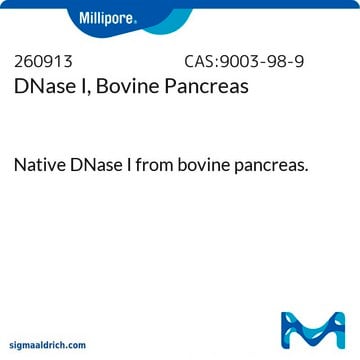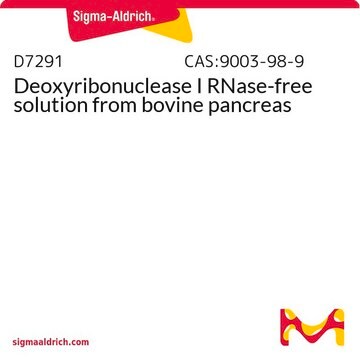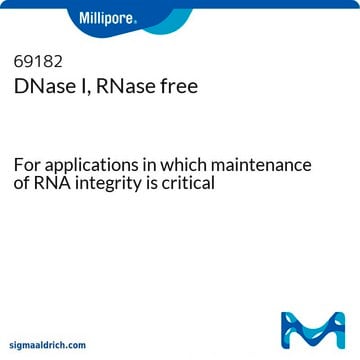As cited in the product listing and datasheet, this product in solution shows an approximate loss of activity of 10% when stored in aliquots at −20 °C for 1 week. Studies at lower dilutions have not been performed. Typically, solutions stored at higher concentrations are the most stable.
Wichtige Dokumente
D5025
Deoxyribonuclease I aus Rinderpankreas
Type IV, lyophilized powder, ≥2,000 Kunitz units/mg protein
Synonym(e):
DNase I, Deoxyribonucleat-5′-oligonucleotido-hydrolase
Größe auswählen
Größe auswählen
About This Item
Empfohlene Produkte
Biologische Quelle
bovine pancreas
Qualitätsniveau
Typ
Type IV
Form
lyophilized powder
Spezifische Aktivität
≥2,000 Kunitz units/mg protein
Mol-Gew.
~31 kDa
Aufgereinigt durch
chromatography
Zusammensetzung
Protein, ≥80%
Methode(n)
DNA purification: suitable
Löslichkeit
0.15 M NaCl: soluble 5.0 mg/mL, clear, colorless
Eignung
suitable for molecular biology
Anwendung(en)
diagnostic assay manufacturing
diagnostic assay manufacturing
Fremdaktivität
Chymotrypsin ≤0.5%
Protease ≤0.05%
RNase ≤0.02%
Versandbedingung
wet ice
Lagertemp.
−20°C
Suchen Sie nach ähnlichen Produkten? Aufrufen Leitfaden zum Produktvergleich
Anwendung
Biochem./physiol. Wirkung
Einheitendefinition
Physikalische Form
Angaben zur Herstellung
Hinweis zur Analyse
Inhibitor
Signalwort
Danger
H-Sätze
P-Sätze
Gefahreneinstufungen
Resp. Sens. 1
Lagerklassenschlüssel
11 - Combustible Solids
WGK
WGK 3
Flammpunkt (°F)
Not applicable
Flammpunkt (°C)
Not applicable
Hier finden Sie alle aktuellen Versionen:
Analysenzertifikate (COA)
Die passende Version wird nicht angezeigt?
Wenn Sie eine bestimmte Version benötigen, können Sie anhand der Lot- oder Chargennummer nach einem spezifischen Zertifikat suchen.
Besitzen Sie dieses Produkt bereits?
In der Dokumentenbibliothek finden Sie die Dokumentation zu den Produkten, die Sie kürzlich erworben haben.
Kunden haben sich ebenfalls angesehen
Protokolle
To standardize a procedure for the enzymatic assay of Deoxyribonuclease I.
-
Good afternoon, if the stock concentration of 10mg/ml may loose 10% of its activity after one week, I was wondering if it is okey regarding stability to keep 500ug/ml aliquots at -20ºC for several weeks.
1 answer-
Helpful?
-
-
Is Kunitz unit same as unit here? I have seen some papers and they have U/ml for DNase. How can i conver it?
1 answer-
Product D5025, Deoxyribonuclease I is given in Kunitz units. This product is a powder. When reconstituting the product with a solution, for example 15,000 Kunitz units in 1 ml of 0.15 M NaCl the end-user will have 15,000 Kunitz units/ml.
Helpful?
-
-
What concentration of Product D5025, Deoxyribonuclease I (DNase I), is required to remove DNA from solutions?
1 answer-
DNA can be removed from preparations by incubation with 20 - 50 ug DNAse I in the presence of 50 mM Tris-HCl buffer, pH 7.5, 10 mM magnesium chloride, at 37°C. for 60 min.
Helpful?
-
-
What is the Department of Transportation shipping information for this product?
1 answer-
Transportation information can be found in Section 14 of the product's (M)SDS.To access the shipping information for this material, use the link on the product detail page for the product.
Helpful?
-
-
How should I prepare a solution of Product D5025, DNAse I?
1 answer-
This enzyme can be reconstituted in 0.15 M NaCl at a concentration of 10 mg/ml.
Helpful?
-
-
How do Deoxyribonuclease I (DNase I), products D5025 and D4527 differ from each other?
1 answer-
Both of these products have the same specific activity (>2000 units/mg protein) for Dnase I. The enzyme impurity levels for each, however, are different. D5025 has the following impurity specification: Chymotrypsin (<0.5%), Protease (<0.05%), and RNase (<0.02%). The impurity specifications for D4527 are: Chymotrypsin (<0.01%), Protease (<0.005%), and RNase (<0.01%).
Helpful?
-
-
Are stock solutions of Product D5025, Deoxyribonuclease I (DNase I), stable?
1 answer-
Solutions of DNAse I (10 mg/ml) in 0.15 M NaCl may lose 10% of its activity when stored for a week in aliquots at -20°C. The same solutions stored in aliquots at 2 - 8°C. lose approximately 20% activity.
Helpful?
-
-
How can I convert units of Product D5025, Deoxyribonuclease I (DNase I), to mass?
1 answer-
The mg of solid for each unit package size will be indicated on the label of the package. For a particular lot, you can calculate the specific activity in units per mg solid by multiplying the specific activity in units per mg protein by the percent protein divided by 100.
Helpful?
-
Active Filters
Unser Team von Wissenschaftlern verfügt über Erfahrung in allen Forschungsbereichen einschließlich Life Science, Materialwissenschaften, chemischer Synthese, Chromatographie, Analytik und vielen mehr..
Setzen Sie sich mit dem technischen Dienst in Verbindung.














